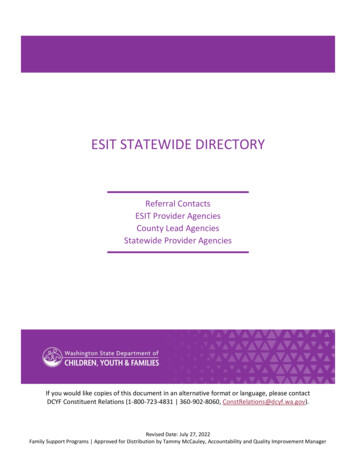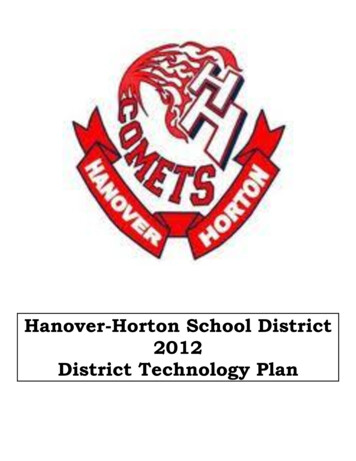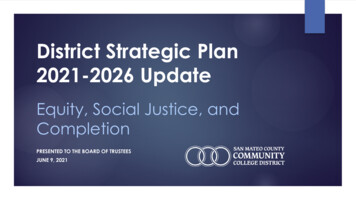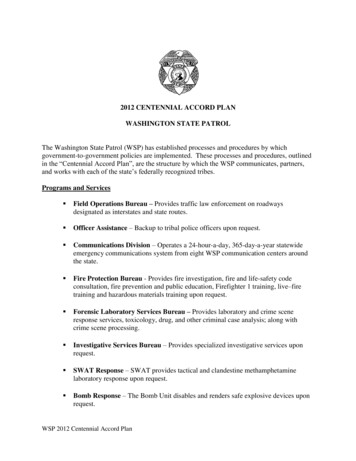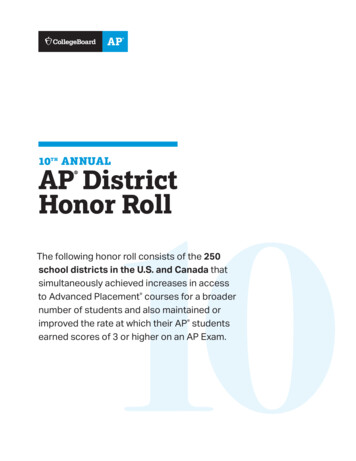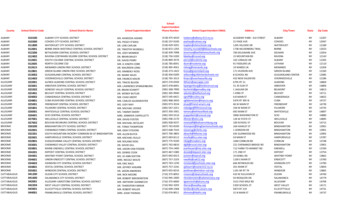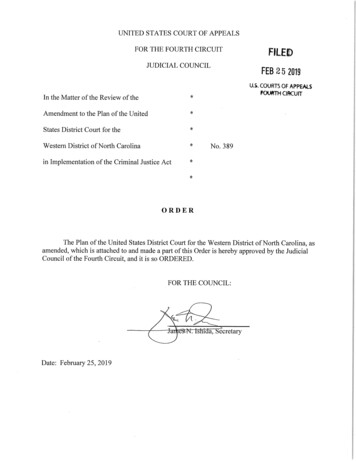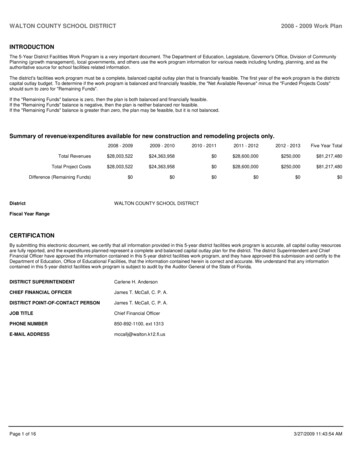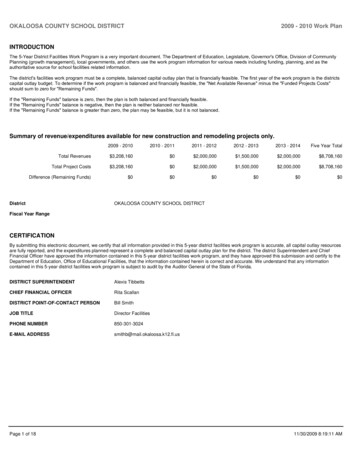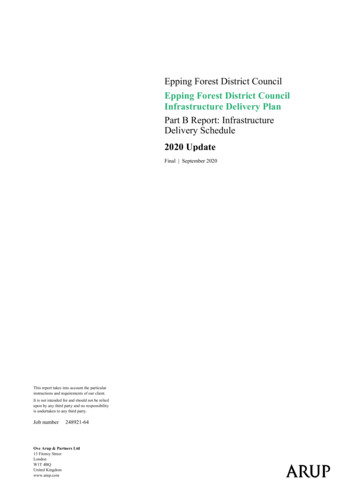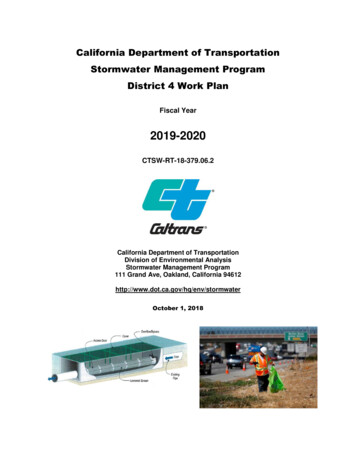
Transcription
California Department of TransportationStormwater Management ProgramDistrict 4 Work PlanFiscal Year2019-2020CTSW-RT-18-379.06.2California Department of TransportationDivision of Environmental AnalysisStormwater Management Program111 Grand Ave, Oakland, California r 1, 2018
For individuals with sensory disabilities, this document is available in alternate formats upon request.Please call or write to the Stormwater Liaison, Caltrans Division of Environmental Analysis, MS-27, P.O.Box 942874, Sacramento, CA 94274-0001, (916) 653-8896 Voice, or dial 711 to use a relay service.
California Department of TransportationDistrict 4 CertificationDistrict Work Plan 2019-20I certify under penalty of law that this document and all attachments were prepared under my direction orsupervision in accordance with a system designed to assure that qualified personnel properly gather andevaluate the information submitted. Based on my inquiry of the person or persons who manage thesystem, or those persons directly responsible for gathering the information, the information submitted isto the best of my knowledge and belief, true, accurate, and complete. I am aware that there are significantpenalties for submitting false information, including the possibility of fine and imprisonment of knowingviolations. [40 CFR 122.22(d)]Tony F. Tavares, District DirectorDistrict 4Date
This page was intentionally left blank.
Table of Contents1Introduction . 1-12District Personnel and Responsibilities . 2-13District Facilities and Water Bodies . 3-14Drinking Water Reservoirs and Recharge Facilities. 4-15Slopes Prone to Erosion . 5-16Implementation . 6-17Region-Specific Activities . 7-18DWP Noncompliance and Improvements . 8-1FiguresFigure 2-1: District 4 Organizational Chart . 2-11Figure 5-1: District 4 2018 Areas Prone to Erosion. 5-3TablesTable 2-1: District 4 Stormwater Personnel and Responsibilities . 2-8Table 2-2: District 4 Signatory Authority for Key Documents. 2-10Table 4-1: District 4 Drinking Water Reservoirs and Recharge Facilities . 4-1Table 5-1: District 4 Inventory of Road Segments Prone to Erosion. 5-1Table 6-1: District 4 Anticipated Project Development and Construction Schedule . 6-3Table 6-2: District 4 Anticipated Significant Road Maintenance Activities . 6-16Table 6-3: District 4 Monitoring Activities . 6-19Table of ContentsiFiscal Year 2019-2020
This page was intentionally left blank.Table of ContentsiiFiscal Year 2019-2020
1IntroductionGeneral Information about the District Work PlanThe District Work Plans (DWPs) describe the organization of each California Department ofTransportation (Caltrans) District’s stormwater program and outline the planned stormwater activities forthe upcoming fiscal year. They are prepared and submitted on October 1 each year. Since the DWP isDistrict-specific, each Regional Water Quality Control Board (RWQCB or Regional Board) is provided acopy of the DWPs relevant to their jurisdiction.This DWP presents information about District 4’s water bodies, Best Management Practices (BMPs), andmonitoring programs. It describes how the District will specifically implement the requirements of theStatewide Stormwater Management Plan (SWMP) during fiscal year 2019-20. Implementation activitieswill be conducted in accordance with the procedures presented in the SWMP. In addition, this DWPfulfills Provision E.3.b of the National Pollutant Discharge Elimination System (NPDES) StatewideStorm Water Permit Waste Discharge Requirements (WDRs) for State of California Department ofTransportation (Order Number 2012-0011-DWQ, NPDES Number CAS000003, Effective July 1, 2013)(NPDES Permit). The NPDES Permit was amended by Orders WQ 2014-0006-EXEC (January 17, 2014),WQ 2014-0077-DWQ (May 20, 2014), and WQ 2015-0036-EXEC (April 7, 2015). A conformed NPDESPermit was issued on April 7, 2015 (Conformed NPDES Permit), available on the California State WaterResources Control Board’s (SWRCB) website:http://www.waterboards.ca.gov/board decisions/adopted orders/water quality/2012/wq2012 0011 dwqconformed signed.pdfThe NPDES Permit was further amended by Order WQ 2017-0026-EXEC on November 27, 2017. Thispermit amendment describes the primary modifications to several Areas of Special BiologicalSignificance (ASBS) sampling locations and incorporation of compliance units crediting due to the StateWater Resources Control Board’s (SWRCB) adoption of the trash provisions on April 7, 2015 (effectiveon December 3, 2015).The DWP’s eight sections describe how the District plans to implement the stormwater program duringthe upcoming fiscal year. Section 1 introduces the DWP, describes its organizational structure, andidentifies the key goals and commitments made by the District for the upcoming fiscal year. Section 2describes the personnel with stormwater operations responsibilities in the District. In Section 3, theDistrict’s facilities are listed and categorized by type and location. Section 4 describes and identifies thehigh-risk locations where spills from the District’s owned rights-of-way, roadways or facilities candischarge directly to a drinking water reservoir or ground water recharge facility. In Section 5, theDistrict’s road segments that are prone to erosion are identified. Section 6 summarizes the District’simplementation activities, including projects that will be in the design and construction phases during thefiscal year, maintenance projects, and planned stormwater monitoring activities. Section 7 identifies theplanned region-specific activities (if applicable) to address the requirements listed in Attachment V of theConformed NPDES Permit. Section 8 identifies deviations that occurred from the prior DWP that resultedor will result in noncompliance with the Conformed NPDES Permit or SWMP and describesimprovements performed in response to the incidents of noncompliance.District Goals and CommitmentsThe current goals for District 4 include: developing and implementing sustainable BMPs that provide a maximum water quality benefitwith minimal life-cycle costs, while providing a safe transportation system for our users andworkers;Section 1: Introduction1-1Fiscal Year 2019-2020
working with local partners to develop alternative compliance/watershed-based solutions that arecost-effective; andimplementing public outreach efforts.The District plans to accomplish this by continuing to: train staff on the Conformed NPDES Permit provisions related to new development andredevelopment requirements that require stormwater treatment, hydromodification controlmeasures, and incorporating full trash capture measures to comply with the San Francisco BayRegion’s trash reduction requirements; coordinate with local partners to provide guidance in the planning and design phase to ensurecompliance with NPDES permit provisions facilitate discussions with the Regional Board(s) on alternative compliance/off-site watershedbased solutions to provide equivalent water quality benefit; train staff on the use of the updated Caltrans Stormwater Project Planning and Design Guide; train staff on compliance requirements in the Construction General Permit (CGP); engage in discussions with the Regional Board(s) to meet our shared stormwater managementgoals: oEstablishing clarity and consistency with Caltrans’ practices for compliance withstormwater treatment and hydromodification control requirements for capital projects,specifically projects that require Clean Water Act Section 401 Water QualityCertifications and/or Waste Discharge Requirements;oEstablishing clarity on alternative stormwater treatment compliance project requirementsto provide equivalent water quality benefit, when on-site stormwater treatmentcompliance measures have been deemed infeasible, based on engineering/economicfeasibility considerations;oSuccessfully implementing construction site risk assessment and water pollution controlmeasures designed to minimize the risk for pollutant discharges into receiving waters asrequired in the CGP;comply with the Attachment IV (TMDL -Total Maximum Daily Load) and V (region-specific)requirements by:o exploring opportunities to incorporate stormwater treatment BMPs on our capital projectsthat yield Compliance Units (CUs) and trash control BMPs within significant trashgeneration areas (STGAs);o partnering with local municipal separate storm sewer system (MS4) permittees to developprojects that maximize water quality benefit by funding projects that: maximize annual TMDL compliance units within TMDL priority reachesapproved by the State Water Resources Control Board ; maximize implementation of trash control BMPs within STGAs.North Coast RegionTo address sediment sources within sediment impaired watersheds, Caltrans will prepare an inventory ofsources of excess sediment and quantify the discharge or threatened discharge in the North Coast Region.Section 1: Introduction1-2Fiscal Year 2019-2020
San Francisco Bay RegionTrash Load ReductionCaltrans conducted visual assessments of its right-of-way (ROW), approximately 20,050 acres in 2016 toidentify STGAs. Caltrans is presently working with the Regional Board to re-evaluate its ROW to identifyany additional STGAs that need to be incorporated in its trash control efforts. The trash re-assessment studywill be completed in November 2018.Caltrans plans to submit an updated District 4 Trash Reduction Work Plan to the Regional Board in March2019 that summarizes: STGAs identified through visual assessmentsSTGA benchmarks that will be addressed with timelinesa plan to consider structural BMP retrofits on capital projects within its ROWa coordination plan with local agencies to develop BMP retrofits outside Caltrans ROWa plan for exploring enhanced maintenance measuresa plan for monitoring and reporting progress towards meeting the STGA benchmarksa plan for continued public education efforts – “Protect Every Drop” campaignStormwater Pump StationsCaltrans performed inspection and monitoring of pump stations in the San Francisco Bay Region. A totalof 62 pump stations were inventoried within District 4. Pump stations within Caltrans District 4 wereevaluated to determine which stations represented the greatest probability for discharging runoff with lowdissolved oxygen (DO) into the local waterway(s). In accordance with the Caltrans NPDES permit,Attachment V, Part 2, Provision 2b, Caltrans inspected and collected DO data annually from 20 percent ofthe pump stations once a year (100 percent to be completed in five years). The inspection and monitoringresults are reported in the District’s fiscal year 2018-2019 Annual Report will be the fifth of five years inwhich inspection and monitoring have been conducted.Section 1: Introduction1-3Fiscal Year 2019-2020
This page was intentionally left blank.Section 1: Introduction1-4Fiscal Year 2019-2020
2District Personnel and ResponsibilitiesSection 2 of the DWP describes positions, addresses, and telephone numbers of personnel withresponsibilities for stormwater operations within the District. This section also identifies positions havingsignatory authority for various notifications or documents required for submittal by a District (e.g.,Project Registration Documents, including Notices of Intents or NOIs).Water Quality Program ManagerThe District Water Quality Program Manager (Program Manager) is the Office Chief of the Office ofWater Quality and Mitigation. The Program Manager supervises the Stormwater Design CoordinationBranches, the District NPDES Coordination Branch, the Water Quality Permits Branch, and the WaterQuality Construction Support Branch. The Manager oversees all stormwater activities in the District. TheManager is also accountable for establishing an effective water quality/Stormwater Management Programand maintaining a liaison with Headquarters and District Program Managers (Division Chiefs) foreffective communication, collaboration, and coordination of stormwater activities.The responsibilities of the Manager are as follows: Direct District operations regarding water quality and stormwater. Align District efforts to interpret, implement, and comply with the Caltrans NPDES permit. Be the ultimate signatory authority in the District for all compliance documents and commitmentsregarding water quality and stormwater management. Work as the primary liaison on water quality and waste discharge issues between the District andHeadquarters, the SWRCB, the RWQCBs, the U.S. Environmental Protection Agency (U.S.EPA), and other agencies. Arbitrate disputes and disagreements on policies, activities, assignments, and responsibilitiesregarding stormwater issues.District NPDES CoordinatorThe District NPDES Coordinator is responsible for providing technical assistance to guide staff inresolving water quality permitting issues and concerns related to project development design, constructionand maintenance with respect to Caltrans compliance with the statewide NPDES Permit andproject-specific permits from the RWQCBs and/or other resource agencies. The District NPDESCoordinator provides functional unit support to Project Managers, Project Engineers and other Districtand HQ functional units and Divisions for all phases of project activities, by providing support inobtaining project-specific permits from the RWQCB(s) and assisting with responding to enforcementactions from the RWQCBs.The specific stormwater tasks for which the NPDES Coordinator is responsible for include: Serving as the focal point for the interpretation and implementation of the Caltrans NPDESPermit. Serving as the District’s Stormwater Mitigation Program Advisor to develop and implement awork plan to ensure the District’s performance objectives (stormwater treatment/complianceunits) in the Ten-Year State Highway System Management Plan are met. Participating in coordination activities with Headquarters Stormwater Advisory Teams(SWATs) – Water Quality and Project Design.Section 2: District Personnel and Responsibilities2-1Fiscal Year 2019-2020
Preparing the Annual Report that summarizes the stormwater activities for District 4 and ensuringthat the conditions of the Caltrans NPDES Permit have been met. Preparing the DWP annually in a manner that addresses future District goals and commitments incompliance with Caltrans’ SWMP. Serving as the lead for the implementation of the DWP, fulfilling its commitments and reportingthe progress in the Annual Reports. Ensuring Stormwater Data Report (SWDR) information at each phase of project developmentincluding Project Initiation Document (PID), Project Approval (PA), Plans, Specifications andEstimate (PS&E), and Construction is accurately uploaded to the Stormwater Portal. Coordinating with Resident Engineers and the DSWC to ensure permanent stormwater treatmentcontrol measures are built in accordance with the project plans and document the as-builtcondition for treatment controls that will be included in the Integrated Maintenance ManagementSystem (IMMS) and into the Storm Drain System Inventory (SDSI). Coordinating with District Functional Unit stormwater coordinators to ensure that all activitiesare in compliance with the statewide permit. Assisting functional unit stormwater coordinators in implementing the Enforcement ResponseProgram (ERP) to address and report non-compliance issues. Coordinating with RWQCBs to ensure that the project development processes in the SWMP areconsistently implemented and facilitating discussions to develop processes to address alternativecompliance strategies for stormwater treatment that take engineering and economic feasibilityinto consideration. Coordinating with local MS4 permittees to identify opportunities for partnership on alternativestormwater treatment compliance projects.District Stormwater Design Coordinator(s)The District Stormwater Coordinators (DSWCs) are the Branch Chiefs of the Stormwater DesignCoordination Branches. Under the general direction of the Manager, the DSWCs are responsible fordeveloping and implementing stormwater design guidance District staff and local partners forincorporating stormwater construction site BMPs, design pollution prevention BMPs, treatment andhydromodification control BMPs into capital projects. The DSWCs is responsible for identifying issuesand developing recommendations related to stormwater quality that affect the District projects andactivities. The DSWCs supervise staff that supports and executes activities related to stormwater designduring each of the project development phases - Project Initiation Document (PID); ProjectApproval/Environmental Document (PAED); Plans, Specifications & Estimate PS&E; and Construction).The specific stormwater tasks for which the DSWCs are responsible for include the following: Provide guidance and direction for the preparation, development, and implementation of acomprehensive District Stormwater Management Program. Oversee activities related to the notification procedures for the reuse of lead contaminated soil inaccordance with the variances issued by the Department of Toxic Substances Control (DTSC). Monitor and evaluate the stormwater activities and procedures of municipalities, developers, andother agencies that encroach upon or administer projects within Caltrans’ right-of-way. Establish impartial and equitable decisions that benefit Caltrans in attaining the objectives of theStormwater Management Program. Provide stormwater quality language which is included in Design Project Reports.Section 2: District Personnel and Responsibilities2-2Fiscal Year 2019-2020
Prepare technical water quality studies to assess water quality impacts resulting fromtransportation improvements in compliance with the California Environmental Quality Act and/orNational Environmental Policy Act (CEQA/NEPA). Prepare SWDRs, contract Plans, PS&E for inclusion of construction site, permanent stormwatertreatment and hydrmodification control measures that are designed to improve or minimize aproject’s water quality impacts. Prepare Stormwater Pollution Prevention Plans (SWPPPs), Permit Registration Documents(PRDs) and electronically filing NOI for obtaining coverage under the CGP prior to beginningconstruction. Assist the District Encroachment Permits Branch in evaluating water quality impacts andrequirements of encroachment permit applications. Participate in the Design SWAT. Provide data for inclusion in the DWP and Annual Report. Assist in development of training programs.Water Quality Permits CoordinatorThe Water Quality Permits (WQP) Coordinator is the Branch Chief for the Water Quality Permits Branch.The WQP Coordinator is responsible for providing technical assistance to guide staff in resolving waterquality permitting issues and concerns related to project development design, construction andmaintenance with respect to Caltrans compliance with the statewide NPDES Permit and project-specificpermits from the RWQCBs and/or other resource agencies. The WQP Coordinator provides functionalunit support to Project Managers, Project Engineers and other District and HQ functional units andDivisions for all phases of project activities, by providing support in obtaining project-specific permitsfrom the RWQCB(s) and assisting with responding to enforcement actions from the RWQCBs.The specific stormwater tasks for which the WQP Coordinator is responsible for include: Serving as the focal contact to the RWQCB for any permitting requirements that may impactwaters of the U.S. and/or waters of the state due to construction and maintenance activities. Coordinating the preparation of Technical Water Quality Studies during ProjectApproval/Environmental Document (PAED) phase. Coordinating with the RWQCBs prior to completion of PAED phase, to reach consensus on thestrategy for avoidance and minimization of impacts to waters of the State (including scheduling,construction site water pollution control and stormwater treatment/hydromodification controlmeasures), and the mitigation strategy for unavoidable impacts to waters of the State. Prepares CWA Section 401 Water Quality Certification and/or Waste Discharge Requirements(WDRs) and Caltrans NPDES Permit applications. Coordinate with Districts functional units to ensure environmental commitments in theproject-specific 401 Water Quality Certifications/WDRs are accounted for in the project workplans and fulfilled during the construction and post-construction phases prior to project closeout.Water Quality Construction Support CoordinatorThe Water Quality Construction Support Coordinator (WQCSC) is responsible for providing technicalsupport to the Resident Engineer (RE) to ensure compliance with the Caltrans Statewide NPDES Permit,Construction General Permit (CGP), project-specific Clean Water Act Section 401 Certifications/WasteDischarge Requirements (WDRs) and other NPDES permits for dewatering discharges.Section 2: District Personnel and Responsibilities2-3Fiscal Year 2019-2020
CEESC is responsible for reviewing and recommending approval to the RE for all District 4 WaterPollution Control Plans (WPCPs) and Stormwater Pollution Prevention Plans (SWPPPs), includingDewatering and Discharge Plans (DDPs) and Temporary Creek Diversion System Plans (TCDSPs). TheCEESC will submit approved SWPPPs or other reports to the RWQCBs and the StormwaterMulti-Application Reporting and Tracking System (SMARTS) as required.The CEESC ensures that all enforcement actions or corrections requested by the RWQCBs are promptlyimplemented and documented. The CEESC serves as the primary conduit for information during theconstruction phase for the RWQCBs, Headquarters Construction, and construction field staff. TheCEESC also supports the design related functional units in determining specific project needs andevaluation of water pollution control measures in the field.Erosion Control CoordinatorThe Erosion Control and Mitigation Branch facilitates the incorporation of erosion and sediment controlrecommendations into the planning, design, and construction of all projects within District 4. The ErosionControl and Mitigation Branch Chief is the Erosion Control Coordinator (ECC) and responsible forworking closely with the e District Stormwater Design Coordinator (DSWC) to incorporate erosioncontrol recommendations into the planning, design, and construction of all projects in the District. TheECC also provides field support to Construction, Maintenance, and Permits. The specific stormwatertasks for which the Erosion Control Coordinator (ECC) is responsible include the following: Determine and evaluate stormwater impacts during CEQA/NEPA screening. Evaluate and recommend the vegetation-type for the permanent control and treatment controlmeasures for addressing project stormwater impacts. Identify costs related to erosion control and on-site mitigation/restoration work on programmingdocuments. Prepare and/or review the contract PS&E for inclusion of permanent and/or temporary erosionand sediment control measures that are designed to improve or minimize a project’s water qualityimpacts. Prepare NOTs. Upon completion of a project’s construction, the ECC will electronically file therequired supporting documentation that terminates coverage under the CGP. Ensure that reuse locations of soil-containing lead in accordance with variances issued byDepartment of Toxic Substances Control (DTSC) are not subject to erosion and are stabilized aspart of project design. Assist the District Encroachment Permits Branch in evaluating encroachment permit applicationerosion control requirements. Conduct studies that explore options for improving water quality objectives on highway plantingprojects. Assist in development of training programs -especially training programs that are attributed totasks performed by the Erosion Control staff. Participate in the Design SWAT. Provides Erosion Control language to be included in the Water Quality section of the DesignProject Report.The ECC acts as the liaison with the Headquarters Office of Landscape Architecture to develop, submit,review, and gain approval for all specifications and details related to erosion and sediment control.Section 2: District Personnel and Responsibilities2-4Fiscal Year 2019-2020
Furthermore, the ECC is the contact for the Headquarters Design Program in the approval or concurrencewith specifications related to water pollution control related to erosion and sediment control.Construction Stormwater CoordinatorUnder the general direction of the Division of Construction (Construction), the Construction StormwaterCoordinator (CSWC) is responsible for developing stormwater quality policies and guidance, and dailymanagement of Construction’s stormwater quality program. The CSWC is responsible for the properimplementation of the SWMP and the DWP within Construction. The CSWC supervises staff, whichimplements the program requirements in the field during the construction phase. The specific tasks forwhich the CSWC will be responsible include: Work as the primary point of contact for stormwater issues during the construction phase. Develop and administer stormwater training for Construction staff. Track critical compliance milestones that occur before and during construction. Conduct final project closeout inspections. The CSWC submits final project closeout inspectionresults to the WQPC, which provides RWQCBs with NOCC/NOT for SWPPP projects. Review SWPPPs and provide oversight inspections for SWPPP projects. Prepare and submit Illicit Connection/Discharge reports for Construction. Participate on the Construction SWAT identified in the SWMP and represent Construction in theStormwater Management Committee (SWMC) meetings. Provide data for the Annual Report. Provides WQPC with Final SWPPP Close-Out report for NOCC documentation.The CSWC ensures that all enforcement actions or corrections requested by the RWQCBs are promptlyimplemented and documented. The CSWC serves as the primary conduit for information during theconstruction phase for the RWQCBs, Headquarters Construction, and construction field staff. The CSWCalso supports the design related functional units in determining specific project needs and evaluation ofwater pollution control measures in the field.Maintenance CoordinatorThe Maintenance Coordinator is responsible for communicating with the District Division Chiefs ofMaintenance and the Maintenance Operation Team (MOT) regarding the proper implementation ofmaintenance related sections of the SWMP and the DWP. The Maintenance Coordinator reports allstormwater related maintenance activities to the SWMC. The specific stormwater tasks for which theMaintenance Coordinator is responsible include: Oversee maintenance activities to ensure compliance with environmental permits and the SWMP. Review, monitor, and evaluate BMP implementation and effectiveness for Maintenance activities. Coordinate stormwater training for District Maintenance staff. Oversee Vegetation Control Plan (VCP) compliance and prepare VCPs. Conduct Facility Pollution Prevention Plan (FPPP) inspections and prepare Facility PollutionPrevention Plans (FPPPs). Participate in the Maintenance SWAT as identified in the SWMP and represent Maintenance inthe SWMC Meetings.Section 2: District Personnel and Responsibilities2-5Fiscal Year 2019-2020
Review SWDRs and other project reports for SWPPP projects to ensure compliance withMaintenance requirement as well as ensure maintainability of stormwater control measures uponcompletion of construction. Serve as the primary contact for Maintenance related activities with regulatory agencies. Provide data for the District Work Plan and Annual Report.The Maintenance Coordinator is chairperson of the MOT that meets routinely to discuss water qualityissues, update the Maintenance portion of the DWP, and compile information for the Annual Reports aswell as the SWMP. The Maintenance Coordinator also serves as the conduit for information between theSWMC and maintenance offices, as well as the Headquarters Maintenance Program (especially theMaintenance SWAT as identified in the SWMP).Right-of-Way RepresentativeThe Right of Way (ROW) Representative is a member of the SWMC and is responsible for the following: Attend all SWMC meetings and report any ROW stormwater activities. Ensure that stormwater training is available to ROW Agents tasked with property inspectionresponsibilities. Ensure that regular property inspections include stormwater inspections. Maintain documentation of the i
Caltrans performed inspection and monitoring of pump stations in the San Francisco Bay Region. A total of 62 pump stations were inventoried within District 4. Pump stations within Caltrans District 4 were evaluated to determine which stations represented the greatest probability for discharging runoff with low
